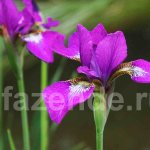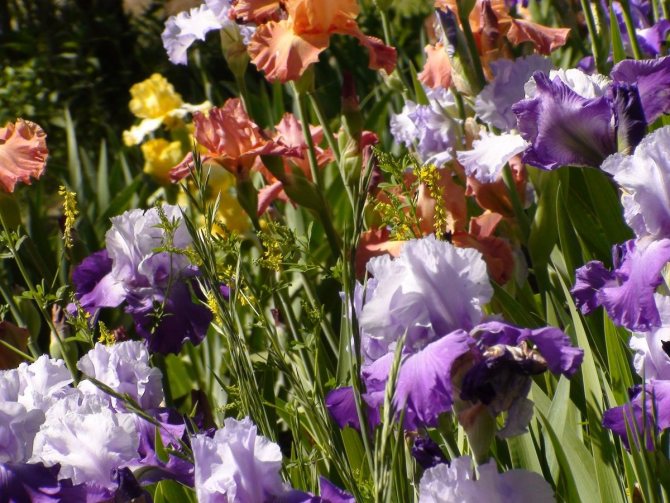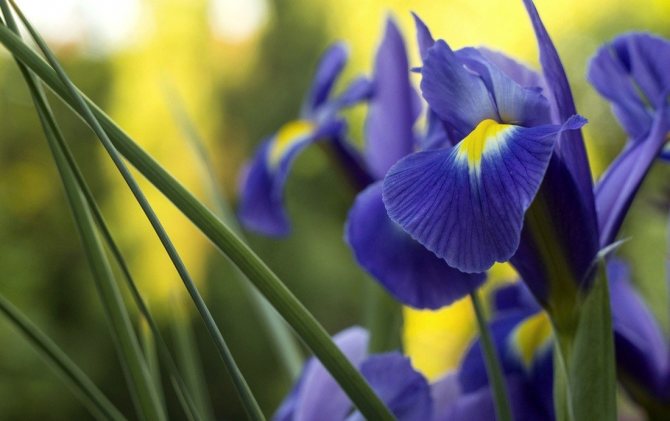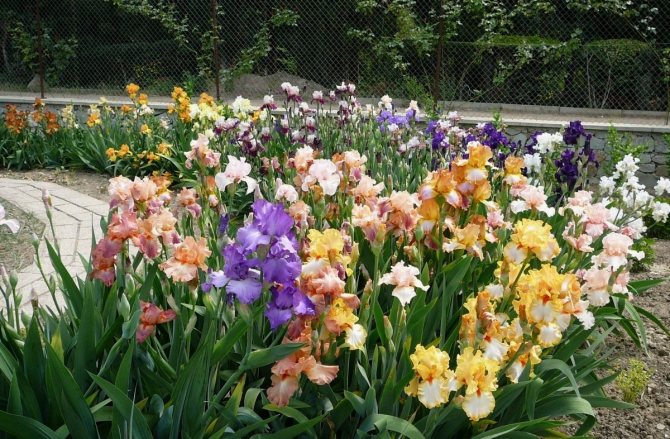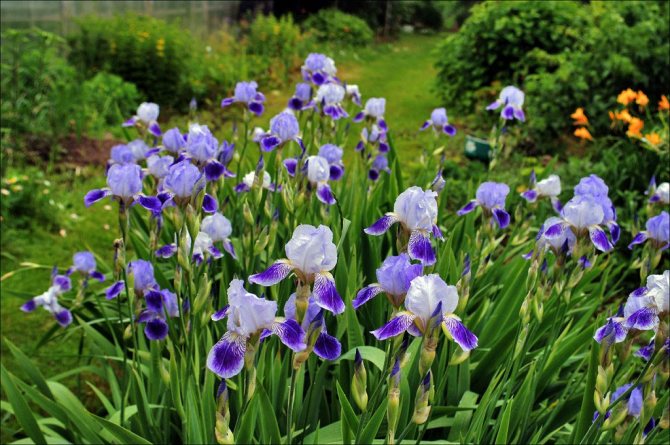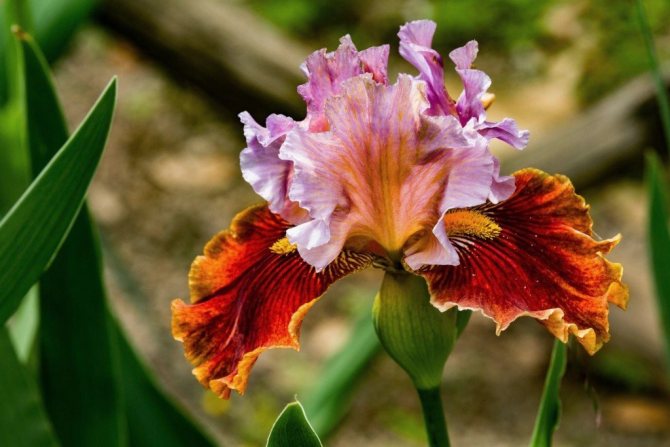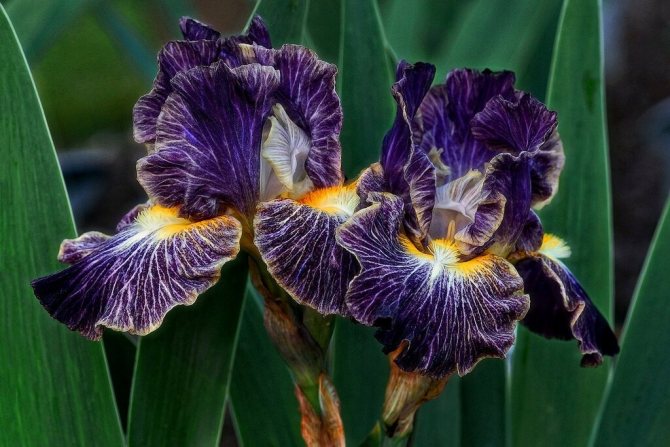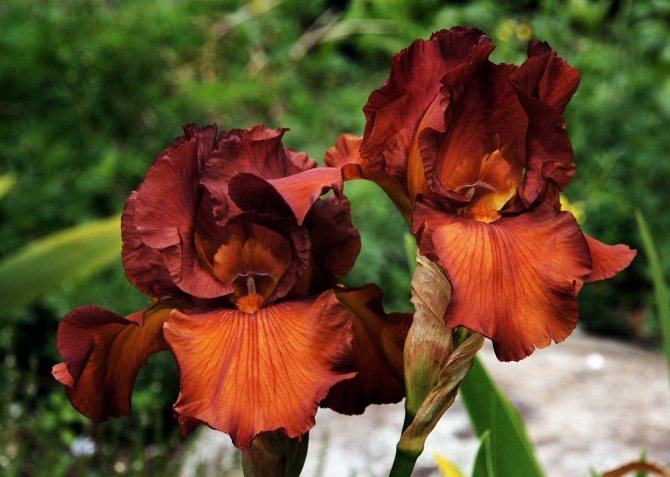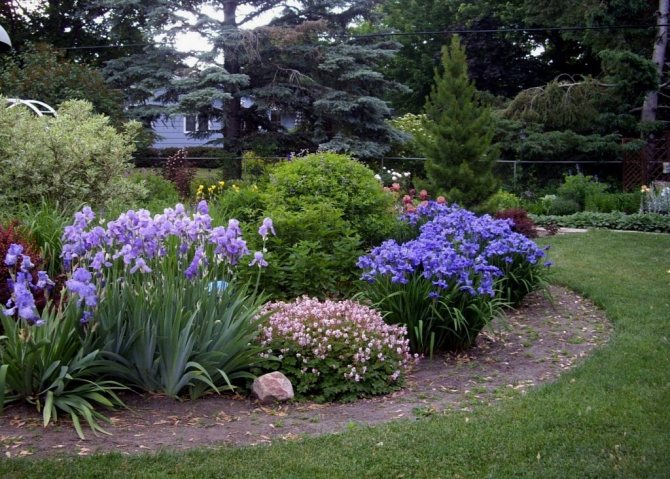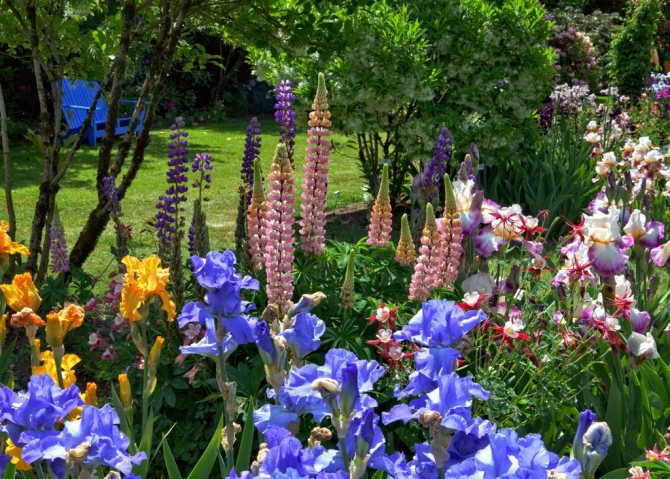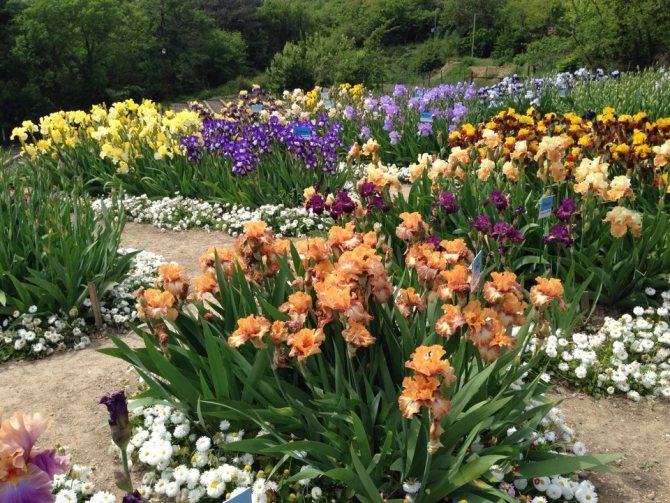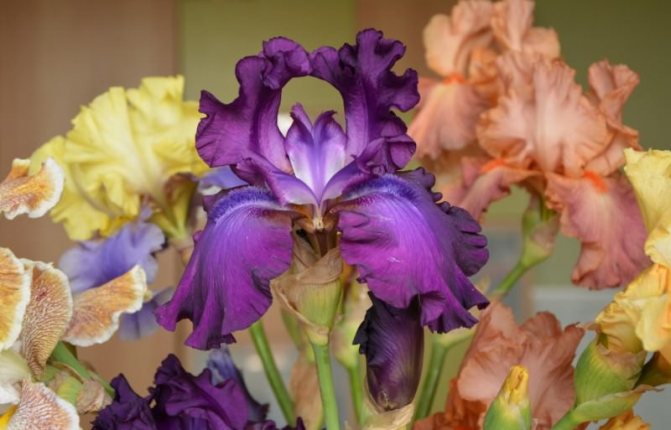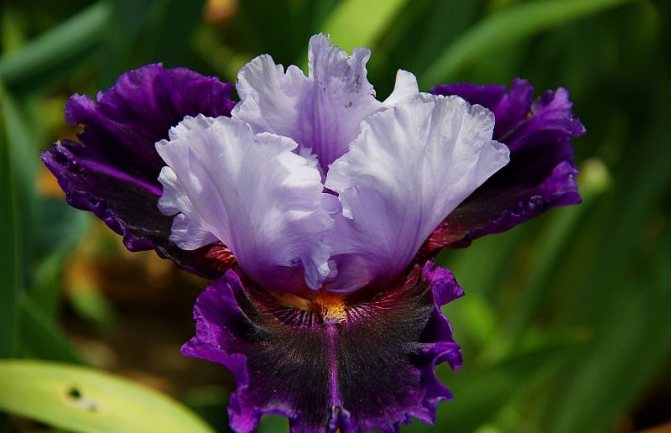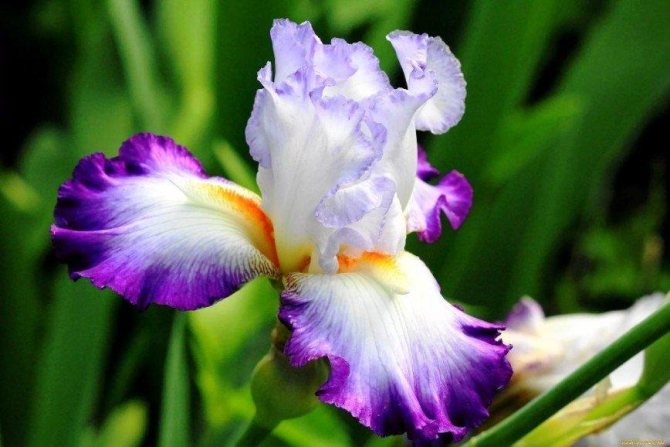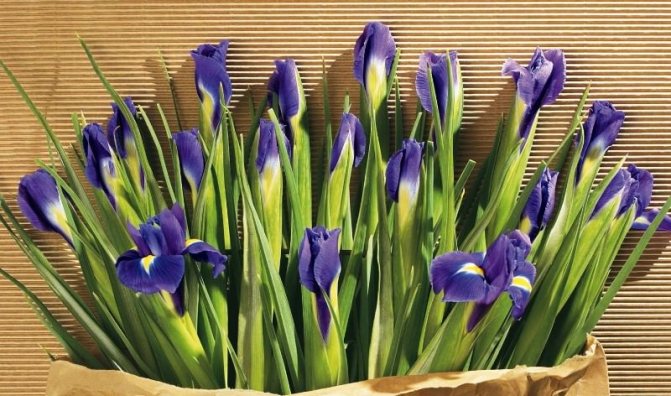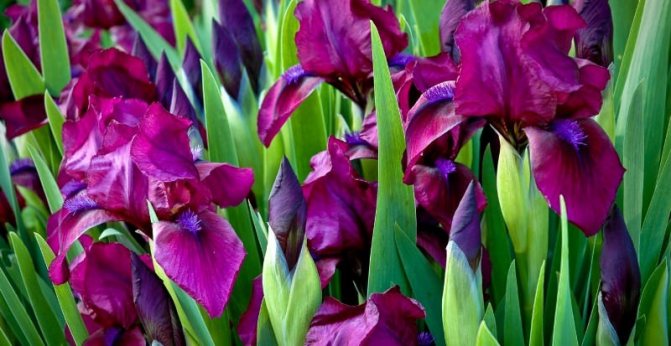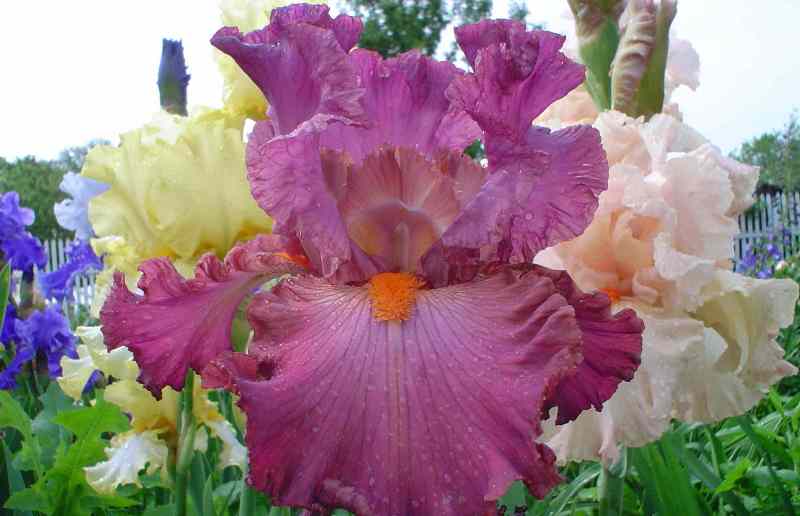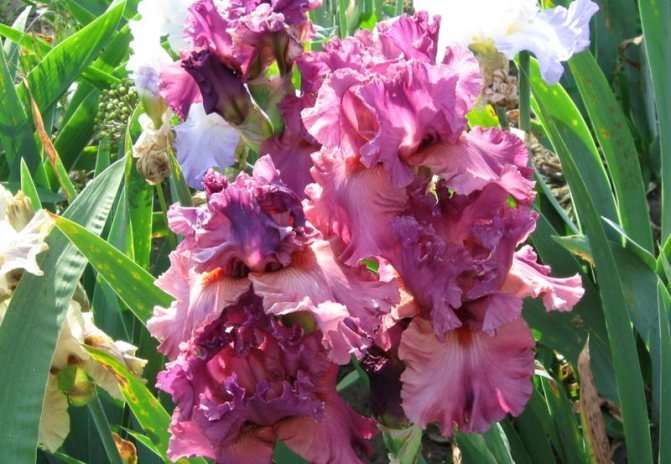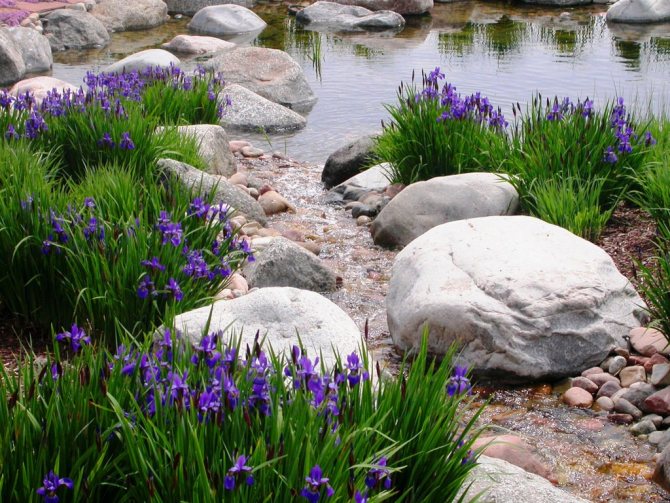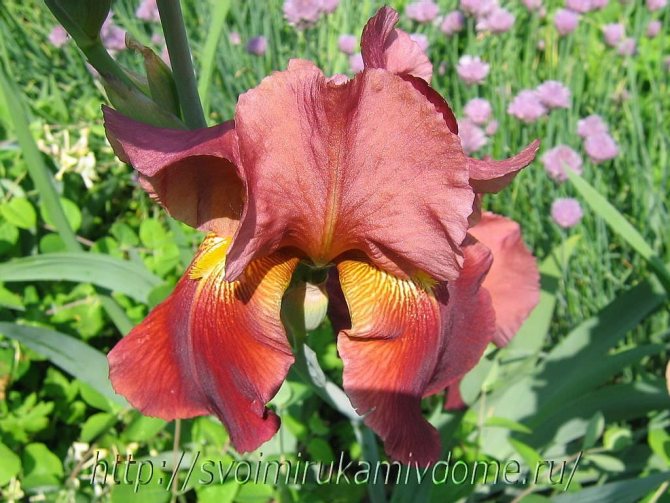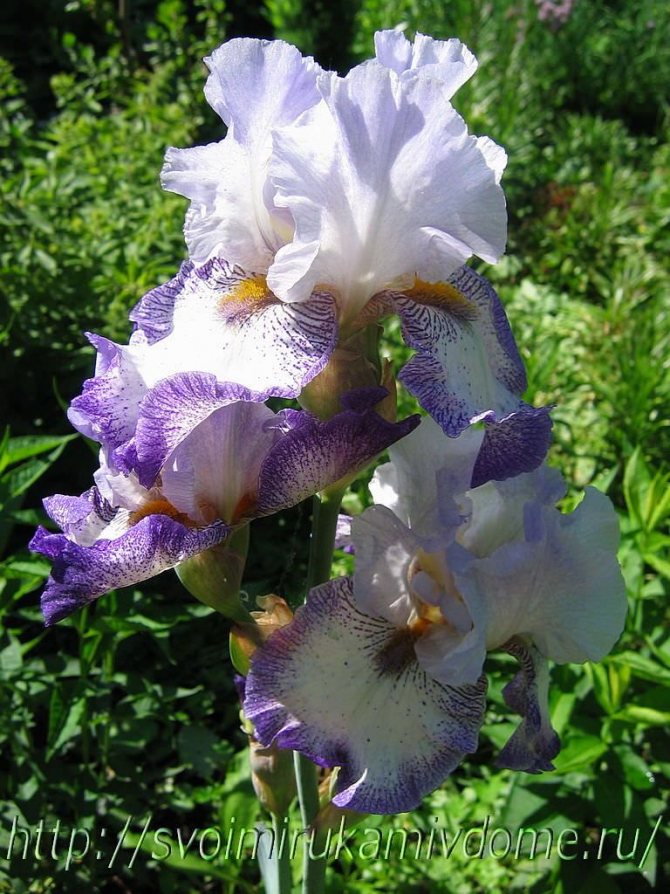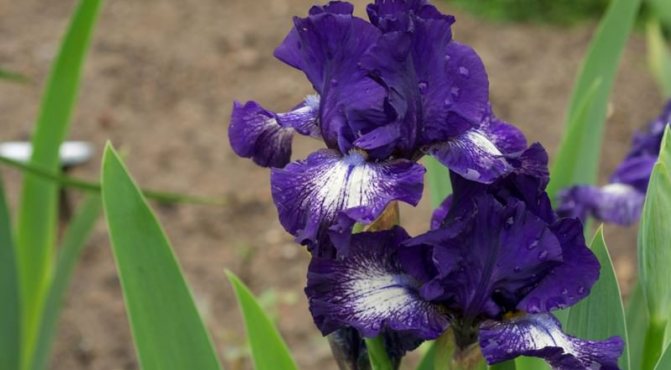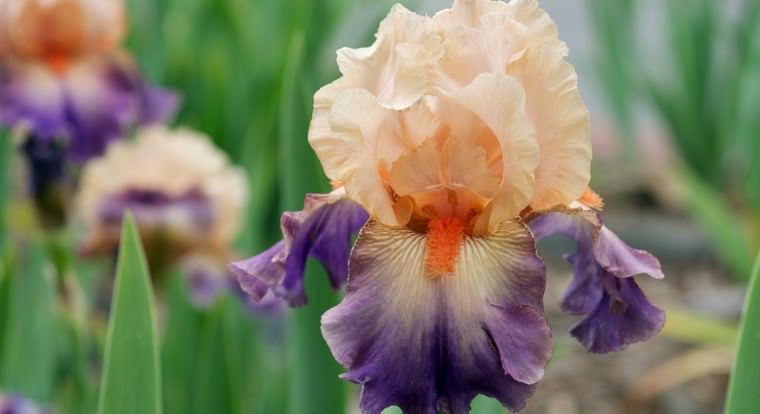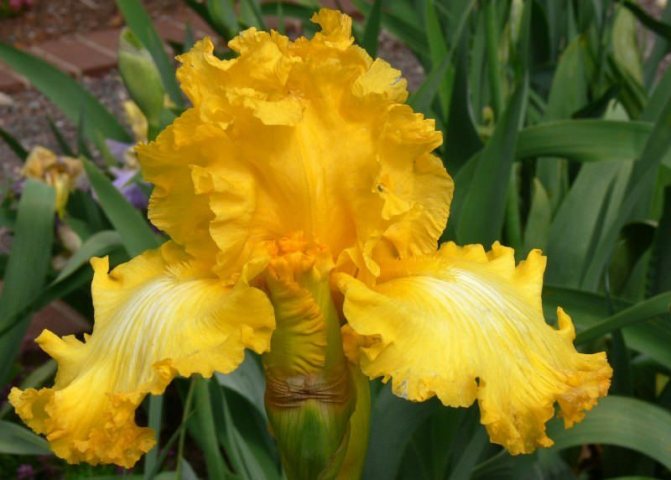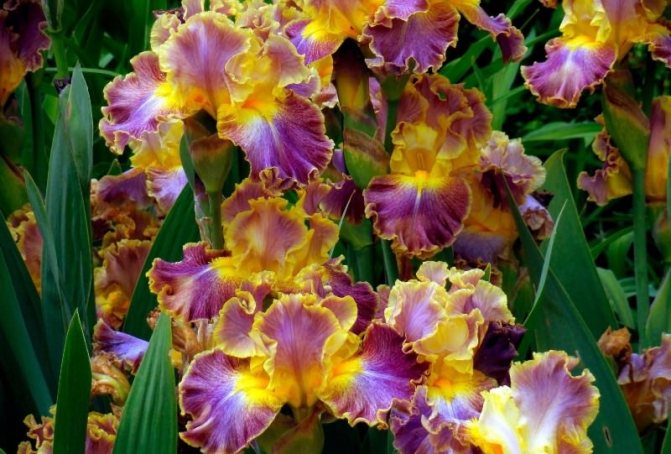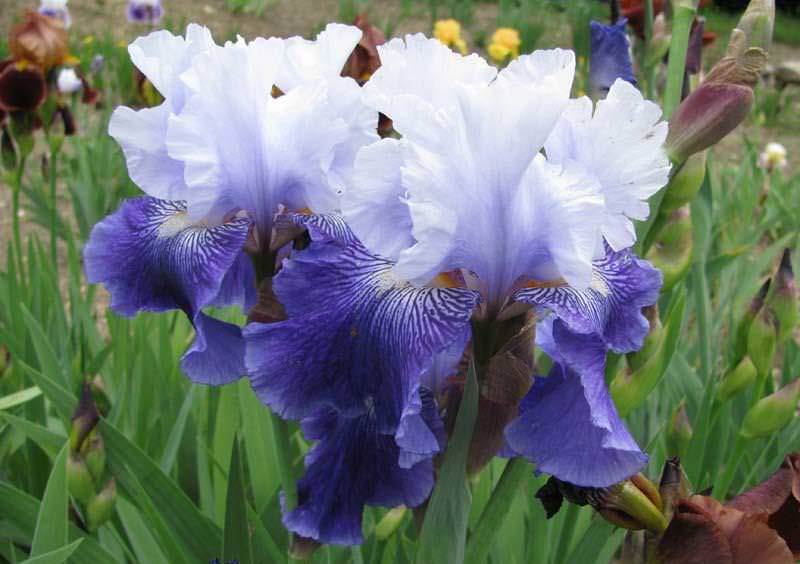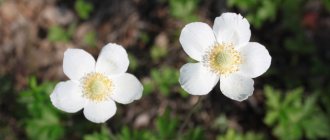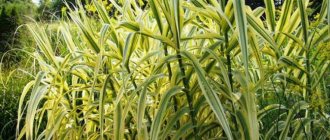Irises are flowers that can be found in every flower bed. They are in great demand for landscape design. Looks great in a single group and in combined landings. If you want to decorate your backyard area with irises, check out their varieties and choose the one that suits you best.
Irises <409
Types of irises and their combination with other crops
The popularity and demand for irises in garden landscaping is easy to explain. Perennial culture is unpretentious in planting and care. Its cultivation is accessible even to a beginner, and bright flowering can decorate any corner of the yard. Today, many varieties are known. All of them are combined into 2 large groups:
- bearded - on the outer petals of these flowers there are hairs that resemble a beard;
- beardless - have yellow spots.
Attention! These species differ in growing conditions. Bearded varieties prefer dry, sunny areas, while beardless ones should be planted in damp, shaded areas, near bodies of water.
Most often, irises produce buds of blue, blue or purple hues. It is these colors that are usually lacking in a green landscape, which is replete with red, pink, white, yellow flowers. In addition to the perennials of the traditional blue-purple scale, it is easy to find varieties with petals of other shades: white, yellow, brown, burgundy, pink or peach. There are monochromatic and two-colored plants. Thanks to their rich palette, irises are in perfect harmony with such flower crops and shrubs:
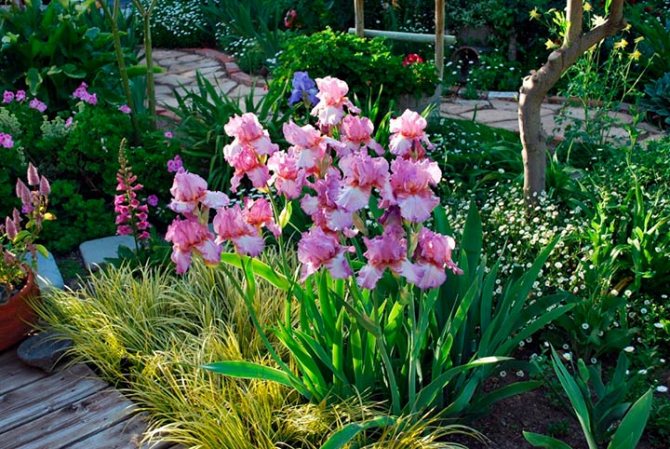
- poppy;
- lily;
- day-lily;
- lupine;
- juniper;
- barberry;
- forsythia;
- host;
- astilba;
- peas;
- saxifrage;
- phlox;
- currant;
- gooseberry;
- spirea gray;
- thuja;
- derain, etc.
Advice. Before using irises in landscape design, find out how tall they will be: small (up to 35 cm), medium (35-65 cm) or tall (from 65 cm). The location of the flowers depends on this.
When and how to plant irises in the country?
Irises in most cases reproduce vegetatively. They need to be replanted when the root culture is actively developing. Experts recommend carrying out this manipulation in the spring and summer.
Transplanting irises in spring is carried out only by experienced flower growers. This is due to the overly fragile root system during this period. In the fall, they become more fibrous. The planting period of a crop directly depends on its type.
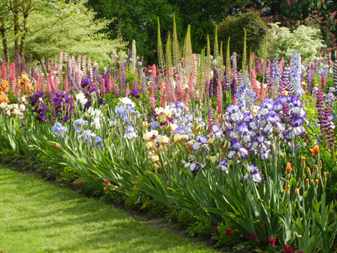

In some cases, the plant is propagated by seeds. This method is less effective and time consuming. Experts recommend planting iris plants immediately after flowering.
In most cases, this culture is transplanted in the fall.... The iris needs a sufficient area for the propagation of the root system. That is why, when planting a plant, it is recommended to maintain a distance of at least 30 centimeters.
Iris does not tolerate excessive moisture. That is why, before planting the iris, high-quality drainage is organized in the hole. The plant is sun-loving, so it should be planted in well-lit areas.
You will be interested in: Decorative flower bed of continuous flowering: which species to choose, how to make
If the soil is poor, then pre-fertilization is recommended. In this case, it is necessary to give preference to complex mineral compositions. After the iris flowers have been planted, watering is carried out, as well as the covering of the near-trunk circle with sand.
Rules for the design of a luxurious iridarium
On the basis of perennials, you can create a beautiful flower bed or even a miniature colorful garden. The latter option is very popular in garden decor and is called iridarium. For its decoration, different varieties and types of irises are used. Designers skillfully select plants by color, flowering time and height.
Attention! In addition to the plant component, the iridarium is characterized by the presence of a reservoir, garden furniture, interesting stones and gravel.
The easiest option is to break a monoclumba of your favorite varieties. The main thing is that they are in harmony with each other. If you want to create a luxurious flower garden, follow these recommendations:
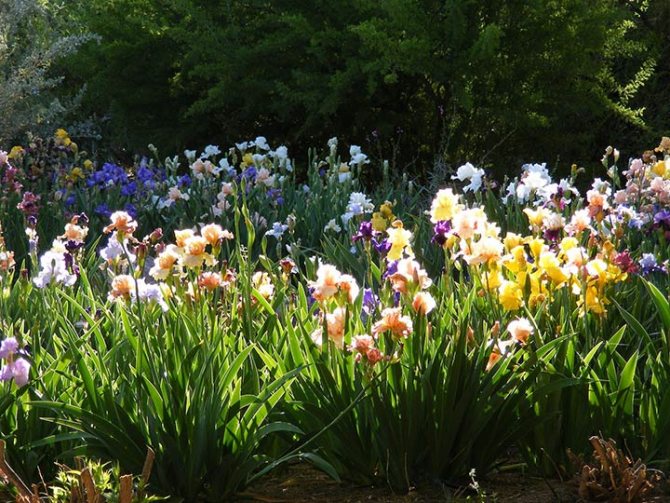

- Plant bicolor varieties on a solid background. A regular lawn will do.
- Do not combine multi-colored crops in the same area. Pick up conifers or crops with pale foliage in a company with them.
- Observe certain spacing between different varieties. For small in height irises, a distance of 10-15 cm is suitable, for medium - 15-20, for high - 35-40 cm.
- Place tall species in the background, and the smallest ones in the foreground.
Description of garden irises
It is no coincidence that representatives of the Iris family are considered one of the most diverse garden perennials. These are unique plants with quivering, delicate flowers, special in structure and texture, which, despite different growth forms, characters, sizes and flowering periods, still remain strikingly similar to each other.
Irises are undoubtedly one of the most ancient flowering crops. The history of their cultivation and selection goes back two millennia, while irises have never survived the period of their oblivion. These are plants that do not lose their popularity, valuable not only for landscape design, but in it they reveal all their diversity and talents.
The name Iris sounds the same anywhere in the world. These beloved plants got their name back in the days of Hippocrates, who, according to legends, compared various shades of the color palette of plants with a rainbow (from the ancient Greek "iris" - "rainbow"), although the name of irises can also be associated with the goddess Iris, announcing the will of the Olympians (which is the messenger of the gods).
The myths about the founding of Florence and many legends of the ancient world from Egypt to Japan are also associated with irises. We like to call irises irises, but still the botanical name of the plant is much more popular.
Irises are not at all uniform in their characteristics. Most irises (and their most famous varieties) are rhizome herbaceous perennials. They are already distinguished by the nature of their growth. Vegetative shoots in the form of rhizomes, consisting of annual links with bunches of leaves and adventitious roots, are located on the surface or immersed in the soil. They are combined with generative shoots - annual peduncles.
Special rhizomes that increase individual links every year determine both the peculiarities of care and the specifics of planting. Flower buds are laid by the plant in summer, their quality depends on the number of leaves in the link.
Iris leaves are among the most recognizable on flower beds. Green matte "swords" in fan-shaped beams are hard not to recognize. Flat, two-row arranged, collected at the base of the peduncles in a fan, linear, xiphoid and rigid, with a unique waxy bloom and light color, iris leaves look spectacular, strict, bright, stand out in any company, bring graphics and structure to the ensembles.Stem leaves in irises are very rare, and even in species that develop medium-sized leaves on peduncles, there are surprisingly few of them.


Irises look perfect in a mixborder and on a curb, on a lawn and even on an alpine slide.
Blooming irises
Despite the beauty of the foliage, irises are prized primarily for their flowering. And they have it, really, amazing. Single flowers or few-flowered inflorescences, in which flowers bloom in turn, look inimitable. Strong, thick, tough, resistant shoots are crowned with simple large flowers with a structure that is hard to miss.
The perianth is divided into six lobes - the upper three, which are called standards in irises, and the lower three falls, which form a unique iris flower and differ from each other. Perianth lobes grow together into a tube, more or less pronounced in different species. The upper petals turning upward are smaller, sometimes reduced, the lower ones are larger, horizontal or bent down, wide, quivering, most often they are decorated with unique details in the form of a fringe, border or beard, spots, patterns.
Most of all, irises are famous for their beards, which are not typical for all species, but they have become the hallmark of the plant - these are strips of soft, dense spikelets located along the central vein. It is on this basis that irises are divided into bearded and beardless.
It is possible to evaluate the structural features of the pistil only after the flower has wilted. It is divided into three lobes, crowned with ridge-like outgrowths, which protect the stigma from getting wet and look very impressive in some species. But the three-nested boxes, ripening on peduncles, do not look too decorative; they are very rarely stored in private gardens to obtain seeds.
Irises are characterized by an amazing fragility of flowers: in some species, they unfold literally for one day. The unique tenderness of the texture of the petals is combined with an amazing ability to unfold the perianth lobes almost by magic and the same almost elusive wilting with a change in texture to translucent. Iris flowers live for a maximum of five days. Due to the fact that the plant one by one, from top to bottom, opens flowers in the inflorescence, the entire flowering period is stretched.
The flowering period of irises lasts the entire first half of the gardening season. From May to early July, and for new late varieties - until mid-summer, different species and varieties delight with a unique watercolor parade.
Bulbous irises, in contrast to their rhizome counterparts, form a medium-sized bulb with reticulate fibrous outer scales, filamentous dying roots and ground faceted leaves. Single-flowered peduncles are quite strong, crowned with an elegant flower, typical for irises, up to 7 cm in diameter.
The six-part perianth corolla consists of internal lanceolate, upwardly directed lobes and oval or ovoid three external lobes - with a short marigold and a lanceolate scapula with a comb-like protrusion. Dissected columns and lanceolate anthers do not distract from the beauty of flower colors.
The color scheme of irises is difficult to describe. All the subtle nuances of colors from snow-white to pale blue and cream, shades of blue, lilac, lilac, violet, purple, dark red, ink, cherry, beige, brown and even yellow and orange colors - in iris varieties you can find unforgettable colors.
Pure monochromatic colors are rare among irises. Spots, erosion, strokes, stripes, contrasting beards or details, borders, rims, specks in two-, three-, or even multi-floral combinations, from contrasting and bright combinations to subtle and almost elusive shades - plants are inimitable in the play of watercolor halftones.And the texture of the quivering and delicate petals of irises, as if shining with mother-of-pearl, silk-satin, velvety, only emphasizes all the nuances.


The group of bearded irises is difficult to confuse with any other.
How else can irises be used in garden landscaping?
Designers willingly create single garden compositions - solitaires - from these luxurious, unpretentious flowers. For group planting, irises of the same type are usually taken, but in different shades. They can be placed against the background of a lawn or ornamental shrub that does not bloom. A composition of varieties that differ in height looks good.
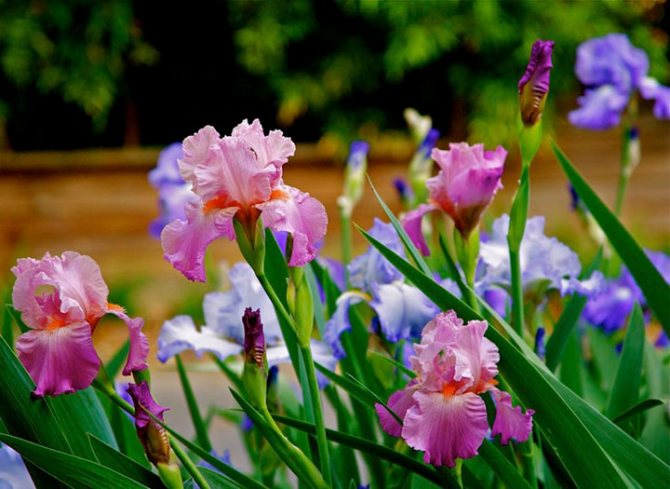

Blooming irises
Another good option for using irises in landscape design is the design of a slide or rockery. For this purpose, it is best to plant miniature varieties. They combine saxifrage, stonecrop, crocuses, small tulips and creeping phlox. Flowers of a dark palette (brown, burgundy, deep purple) can be combined with light decorative stones. Yellow, blue irises should be planted against the background of creeping juniper.
Attention! Tall varieties can disturb the harmonious proportions of rockeries. Flowers of medium height are allowed only in the decor of large hills.
The swamp or Siberian variety of perennial culture is an excellent addition to a natural or artificial pond, lake. A cozy place to relax is decorated with pebbles or gravel. The completeness of the garden composition will be given by the thuja, against which the irises are planted. Also, these flowers are good for decorating ridges, borders. They can be combined with other crops or used in monoplants.
When choosing perennial varieties by shade or height, consider the conditions for their cultivation. Not all irises can be combined with each other in the same area.
Competent care of irises: watering, weeding and spraying
After the irises have been planted, proper care must be taken. It consists in performing certain manipulations:
- Watering;
- Spraying;
- Weeding.
Irises do not like excessive drying out of the soil. That is why regular watering is recommended. Stagnation of water, as well as drying out of the soil, in this case should not be allowed.
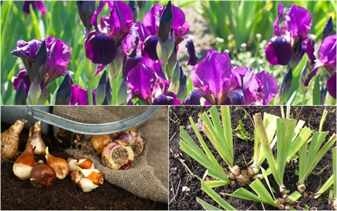

In order to remove dust from the plant, it is recommended to spray it regularly. The manipulation should be performed in the evening after sunset. Irises do not like neighborhoods, which requires regular weeding. In addition, spraying will provide oxygen access to the plant's root system.
Irises are versatile plants that are characterized by an attractive appearance. That is why it is recommended to use them for landscape design in areas that have different sizes.
You will be interested in: Perennial garden flowers for a summer residence or garden: types, planting and design features
How to properly break a flower bed with your own hands
To get a harmonious flower bed, it is worth choosing the right planting layout. It is recommended to choose crops that match in color and size. Solid varieties look good with variegated ones, and dark ones with light ones. It is not worth planting several multi-colored varieties on the same flower bed. Otherwise, they will mix. Plants in a flower garden should not shade each other. Irises are distinguished by a superficial root system, therefore, in addition to them, it is worth choosing plants with deep roots.
The interval between plants should be observed. It is imperative to systematically loosen the soil and get rid of weeds. Cultures should be selected according to the flowering time. Due to this, some plants will fade, while others will begin to bloom.
If there is a reservoir in the country, it is worth planting irises on its shore. The crop goes well with water, and the moist soil allows for rapid growth. It is permissible to decorate the area of the reservoir with irises alone.As a result, you will be able to get a beautiful composition.
Why irises don't bloom
Summer residents growing irises are interested in the question: why irises, with healthy greenery, do not bloom. There are several reasons.
The first reason - weather conditions of autumn and spring. In modern varieties, flower buds suffer from low temperatures without snow cover in late autumn - early winter. They can also die during recurrent spring frosts, when the temperature drops below -7 °.
The second reason - lack of light in the place where irises grow. Bearded irises are photophilous, but they endure sparse and short shading, but falling into a continuous shadow, they stop blooming.
Third reason - long-term growth of plants in one place. Flowering stops if irises grow without replanting for 4–5 years - the soil is depleted and compacted, and strongly overgrown rhizomes push each other and interfere with the normal growth of neighboring ones.
Share the entry
- Similar posts
- Dicenter. The tenderness of a broken heart
- Primrose. Primrose in the garden
- Chinese carnation - an unpretentious beauty in your garden
- Ground cover plants - heavenly bushes for beginners
- What to choose - flowers or vegetables? A vegetable garden in a flower garden!
- Brugmansia or the intoxication of my heart
The choice of planting material
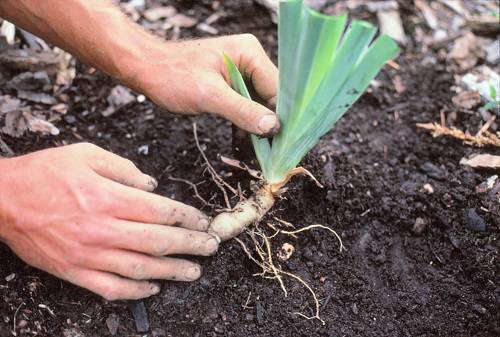

When buying iris planting material, you should carefully look at:
- firstly, by the size of the rhizome itself, because the larger it is, the better the plant takes root, grows faster and blooms earlier;
- secondly, are the rhizomes healthy, are there signs of disease on them;
- thirdly, are the vegetative buds well formed, but at the same time there should not be active vegetative growth;
- fourthly, the rhizomes should be dry, but not overdried.
Secrets of the correct landing
First, let's decide on the place where the flower will grow. Look for sunny, draft-free areas. A hill or a slope will be an additional plus - as a rule, the outflow of melt water is better there. They are planted from early morning until 12.00. In such conditions, bearded black irises feel best. The marsh and Siberian species are recommended to be planted in places with moist soil.
All species, without exception, need rich feeding. If the soil is poor, it is advisable to add compost, phosphorus and potassium fertilizers before planting. Sour soil requires chalk, wood ash or dolomite flour, while sandy soil requires clay soil. Any soil is disinfected with a fungicide. And so that weeds do not grow, they are treated with herbicides.


Planting iris outdoors
Planting in spring
The planting material is treated with a growth stimulator (Ekogel, Zircon). Long roots are pruned, areas with rot are also removed. In a solution of potassium permanganate, the root is lowered by about 1/3, disinfection is carried out. Further actions are performed in the following sequence:
- Dig a hole and cover the sand with a mound.
- Lay the rhizome horizontally, straighten it.
- Cover with soil, leaving the upper part. Water abundantly.
- Sprinkle some fallen needles or mulch on top to retain moisture.
- The holes must be at least 50 cm apart.
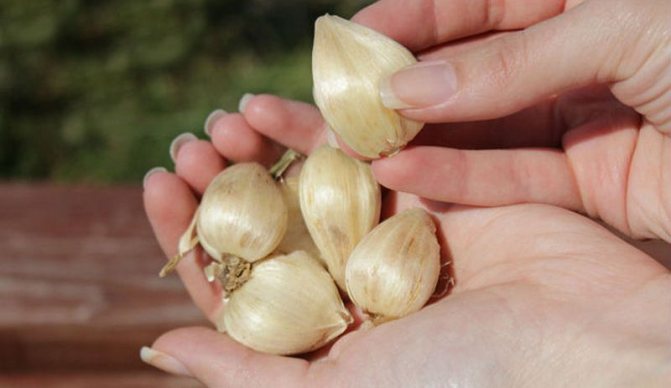

Planting irises in spring
Planting in autumn
Autumn planting practically does not differ from spring planting. Held in August-September. Dig the selected variety (for example, Brassi iris) with a pitchfork and divide it into annual links. Cord-shaped roots are shortened, removing places of decay. All delenki are treated with a solution of potassium permanganate and placed in a sunny place for 4-5 hours. Planted in the same way as in the spring.
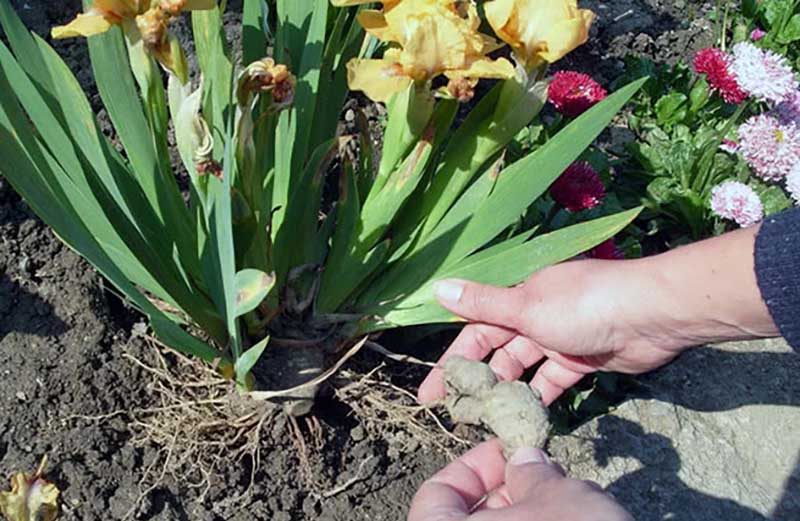

Iris care
Pests and diseases
As practice shows, variegated varieties are most often sick. At the first signs of illness, it is important to take appropriate action as soon as possible. A bush with fusarium disease is immediately dug up and destroyed. Other bushes are watered with a 2% solution of foundationol.A solution of Bordeaux mixture will help to cope with the appearance of various spots - they are sprayed with foliage.
Also, plants can infect scoops that eat the base of the peduncle. First, the buds turn yellow, and then dry out altogether. Any problem is easier to prevent, so do not forget to take preventive measures. Plants are treated with a 10% solution of karbofos, the interval between treatments is 7 days.
Another common problem is gladiolus thrips. These are insidious insects that disrupt photosynthesis in foliage, which is why the leaves turn brown and quickly die off. The plant infected with thrips loses its attractive appearance, the buds become discolored. They fight insects in the same way as with scoops - they use karbofos. An infusion based on makhorka with laundry soap also showed high efficiency.
Slugs can also harm iris. Surprise them with a trap! Burdock leaves or damp rags are placed in the aisles. Slugs rush there - you just have to collect and destroy them.
Growing a flower culture
For amateur gardeners for the propagation of irises, it is best to choose a vegetative method (seed is also possible, but it is more suitable for hybridization) - this will allow you to see flowering already a year after planting. Vegetative propagation is suitable for both wild and varietal flowers. To do this, you need to take a bush, shake off the ground from its roots and break it down so that each of the broken off parts has leaves and rhizomes. Next, you should cut the leaves in half and the roots by a third, clean both of them from rotten and / or dry parts, disinfect with a weak solution of potassium permanganate (hold in it for no more than 15 minutes) and dry. In the middle of the hole dug in the flower bed, you need to make a small slide on which the rhizome should be placed, spreading the roots around. The distance between the holes must be at least half a meter. After planting, the seedlings must be watered, and after three to four days, watering again. If it's hot outside, then the seedlings need to be shaded.
Choosing a neighborhood for dwarf and moisture-loving irises
Stems 35-40 centimeters high are harmonious next to the stones. Therefore, for arranging alpine slides and rockeries, this is the most successful choice. You can plant dwarf varieties of phlox and crocuses nearby. Flowers look interesting against the background of juniper.
See also
Useful properties of marigolds against pests, why plant in the gardenRead
For species loving moisture, there is no better place on the shore of an artificial or natural reservoir. Siberian and Japanese flower species thrive near water. Swamp varieties can be planted directly in shallow water. Care for such plants is easy, as they are unpretentious. Usually, beardless specimens of decorative culture are chosen for shady places. Bearded ones will not be able to bloom in the shade.
What time of year to plant a crop
It is best to plant flowers in summer and autumn. In the summer, the plant will take root one to two weeks after planting, and in the fall within a month and a half. For autumn planting, you should choose specimens with a previously established flower bud and sufficiently developed roots. Under favorable weather conditions, the rooting of the plant will take place without problems, and flowering can be expected as early as next year.

